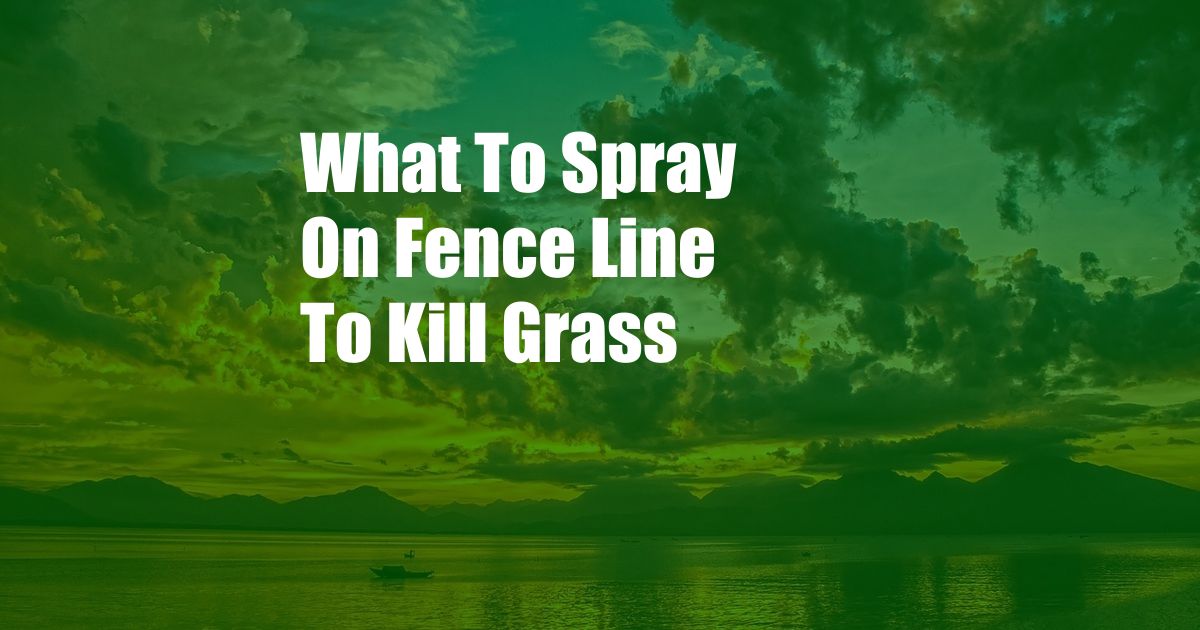
What to Spray on Fence Line to Kill Grass
Tending to your lawn is a time-consuming chore that requires regular maintenance. Keeping up with mowing, weeding, watering, and fertilizing can be a hassle, especially if you have a large yard with a fence line that sprouts unwanted grass.
Fence Line Maintenance
Maintaining the area around your fence line can be a daunting task. Grass can quickly grow out of control, making it difficult to mow and keep your yard looking neat and tidy. Not only is this unsightly to look at, but it can also attract pests and create a breeding ground for weeds.
Defining the Problem
Grass grows along fence lines where soil disturbance and sunlight create favorable conditions for seed germination and growth. In addition to being unsightly, this uncontrolled grass growth can damage fences, especially wooden ones. The moisture and organic matter from grass clippings can hasten the decay of wooden fences, leading to costly repairs.
Herbicide Treatment
The most effective way to kill grass along a fence line is to use a herbicide. Herbicides are chemical compounds that are specifically designed to kill or inhibit the growth of plants. They can be applied directly to the grass, either as a spray or a granular form. When choosing a herbicide, it is important to select one that is labeled for use on the type of grass you are trying to kill. You should also take into consideration the area you need to treat and the safety precautions that need to be taken.
Types of Herbicides
There are two main types of herbicides: systemic and contact. Systemic herbicides are absorbed by the plant and travel throughout its system, killing the entire plant, including the roots. Contact herbicides, on the other hand, only kill the plant tissue that they come into contact with. For fence line treatment, systemic herbicides are more effective as they can prevent regrowth.
Pre-emergent and Post-emergent Herbicides
Herbicides can also be classified as pre-emergent or post-emergent. Pre-emergent herbicides are applied before the grass has germinated, while post-emergent herbicides are applied to actively growing grass. Pre-emergent herbicides are effective in preventing grass from growing in the first place, while post-emergent herbicides are used to kill existing grass.
How to Spray Herbicide on Fence Line
Before applying any herbicide, be sure to read and follow the instructions on the product label carefully. This will help you to use the herbicide safely and effectively.
1. Safety First
Wear protective clothing, including gloves, long sleeves, and pants, when applying herbicide. Avoid spraying on windy days to prevent drift. Keep children and pets away from the area being treated.
2. Choose the Right Herbicide
Select a herbicide that is labeled for use on the type of grass you are trying to kill. For fence line treatment, a systemic herbicide is recommended.
3. Mix the Herbicide
Mix the herbicide according to the instructions on the product label. Be sure to use the correct amount of herbicide and water.
4. Apply the Herbicide
Apply the herbicide to the grass along the fence line, being careful not to spray it on the fence itself. Use a sprayer that is specifically designed for herbicide application. Spray the herbicide evenly over the grass, covering all of the leaves and stems.
5. Allow the Herbicide to Dry
Allow the herbicide to dry completely before allowing children or pets to enter the area. The herbicide will typically take a few hours to dry, depending on the weather conditions.
Tips from the Experts
Here are a few tips from the experts on how to effectively kill grass along a fence line:
- Mow the grass short before applying herbicide. This will help the herbicide to penetrate the grass blades more easily.
- Apply the herbicide on a calm day to prevent drift.
- Be sure to spray the herbicide evenly over the grass, covering all of the leaves and stems.
- Allow the herbicide to dry completely before allowing children or pets to enter the area.
- Repeat the application as needed to prevent regrowth.
FAQ
Q: What is the best way to kill grass along a fence line?
A: The most effective way to kill grass along a fence line is to use a systemic herbicide.
Q: Can I use household vinegar to kill grass?
A: Yes, you can use household vinegar to kill grass. However, it is not as effective as a commercial herbicide.
Q: How long does it take for herbicide to kill grass?
A: Herbicide typically takes a few hours to kill grass. However, it can take up to two weeks for the grass to completely die back.
Q: Can I spray herbicide on a wooden fence?
A: No, you should not spray herbicide on a wooden fence. The herbicide can damage the wood.
Conclusion
Killing grass along a fence line can be a chore, but it is important to keep the area neat and tidy. By following the tips and advice in this article, you can effectively kill grass along your fence line and prevent regrowth.
Are you interested in learning more about fence line maintenance? Let us know in the comments below!